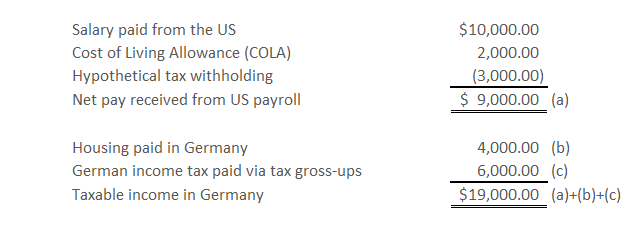Good budgeting and accurate cost accruals start with the tax cost projection calculation. In one of our recent blog articles, 3 Approaches to Accounting for the Tax Costs of an International Assignment, we outlined the basic “nuts and bolts” for capturing assignment tax costs and the considerations that affect which accounting method to select.
Now that the building blocks are in place and you are consistently doing cost projections and booking accruals for the tax costs, it is time to look beyond the basics into three areas that can add complexities to the accrual process.
- Home country payroll, but Host country accounting
- Accrual maintenance and changes to the cost projection
- Impact of equity on accruals
Home country payroll, but Host country accounting
For many tax equalized assignments, a common scenario is to have the employee remain on the Home country payroll, but have the costs of the assignment borne by the entity in the Host country. This is usually done for the following reasons:
- Keeping an employee on the Home country payroll helps to facilitate the ongoing provision of Home country retirement and other company benefits, as well as participation in Home country social security, as much as possible.
- Payment of salary in the Home, rather than Host country, can minimize foreign currency fluctuation risks as the employee can limit the amount converted into Host country currency by only transferring funds needed for local expenses.
- Having the costs borne by the entity in the Host country often aligns with the secondment agreement between the company entity in the Home country and the company entity in the Host country. This can help to minimize the potential for the entity in the Home country to be deemed to have a taxable corporate presence in the Host country (i.e., permanent establishment).
As reflected in our recent blog, under the “full tax accrual method,” it is important to have all tax payments recorded to the accrual account. However, the actual process of recording all payments to that account can be complicated by having tax payments occurring in both the Home and Host country.
To illustrate these issues, let’s walk through an example case study for Nancy, an employee on assignment from the US to Germany:
- Nancy remains on US payroll for her base salary and receives some assignment benefits that are paid on her behalf in Germany.
- Nancy has hypothetical tax withholding from salary paid in the US and German income taxes are paid on her behalf by the company via a shadow payroll.
Based on this fact pattern, the monthly payroll might look something like this (please note that for simplicity, we have listed all figures in US dollars):

In this scenario, the US entity will cross-charge the German entity for the net US pay (i.e., $9,000), and then the Host will book a compensation expense of $9,000. However, if the German entity records this transaction with a single entry, then the hypothetical tax accrual account will be shorted $3,000 each month. This single entry accounting treatment can result in an unpleasant surprise when there is a tax balance due in the Home or Host country (to be paid by the company) and there are not enough funds in the tax accrual account to pay the tax balance due. Instead, the German entity should book the following entry when receiving the cross-charge from the US entity:

Note that in the example above, the compensation expense items can quickly become “buried,” therefore it is important to make sure that all tax items are separately identified and tracked throughout the entire process.
Additionally, the German entity should not record the German income tax payments as an expense; instead, the German income tax payments should be recorded as follows:

As demonstrated in this example, some of the terminology associated with components of tax equalized assignments may be unfamiliar to personnel responsible for maintaining the tax accrual account in the Host country. Accordingly, it is important to make sure that your global accounting team knows which costs to record to the accrual account. Common items include:
- Hypothetical tax (withheld from the employee’s paycheck during the assignment)
- Tax equalization settlement payments (either to or from the employee)
- Tax gross-ups (in the Home and/or Host country)
- Tax balance due payments (in the Home and/or Host country)
- Payments or refunds from amended Home or Host country income tax returns
Accrual maintenance and changes to the cost projection
Setting up an accrual account in the first year of an assignment is critical, but if the accrual account is not revisited until the end of the assignment, then the goal of avoiding surprise tax payments may not be achieved. Internally, it is best to identify an individual who will oversee the assignment accrual accounts, decide with your staff when entries should be made, and discuss where to obtain the information that is needed.
Over time, just like your other internal cost accrual accounts, the assignment cost accrual accounts will require maintenance to ensure that they adhere to your established accounting standards. As with all things in business, the variables associated with employee assignments ebb and flow with time, and the actual costs that result tend to vary from the original costs projected at the beginning. Some of the biggest factors affecting assignment and tax costs during an assignment include:
- Exchange rates: Depending on the country combination(s) in question, world events, or other issues impacting the valuation of currencies could cause differences from projected costs to the actual costs ultimately incurred.
- Projection methodology and timing assumptions: Generally, the methodology incorporated into most tax cost projections assumes that all tax payments are paid in the current year. Specifically, they generally assume there will never be any tax refund or balance due on the Home and Host tax returns, and further, there will never be a refund or balance due on a tax equalization settlement. Since this rarely happens, the cost projection can change due to the timing of when the actual tax payments and equalization settlements occur.
- Changes to the employee’s compensation: During a multi-year assignment, changes to compensation and bonus tiers commonly occur and can affect progression through tax brackets.
- Changes to the allowance amounts: At the onset of the assignment, most allowances are generally only estimates. For example, housing or rental costs may differ once the actual apartment is located and leased. Additionally, government, market, or social conditions may also affect assignment allowances. A recent example of this was the early reaction to Brexit, which quickly affected market prices and exchange rates enough to require sizeable adjustments to cost-of-living allowances in the middle of ongoing assignments.
- Changes to the length of the assignment: Subsequent extensions to original assignment plans are common. At a minimum, assignments that are extended will have additional tax costs commensurate with the extension period. In some cases, depending on the countries involved, certain preferential tax schemes may begin to expire during the extension period, causing increases to tax costs that may not have existed previously. On the other hand, ending an assignment early could either increase or decrease the expected tax costs. For example, an assignment ending too soon may mean that the benefit of the US Foreign Earned Income Exclusion is lost. If the assignment is to a country with a tax rate lower than the US rate, foreign tax credits may not fully offset the additional US tax resulting from the loss of the exclusion and may increase tax cost.
- Changes in tax rates or laws: Periodically, changes to tax laws that affect assignment tax costs do occur, such as the recent US tax law change that has resulted in the taxation of certain employer-paid moving expenses that had previously not been subject to US federal taxation.
A best practice to keep the accrual within acceptable materiality parameters is to request an updated tax cost projection on an annual basis or whenever there is a significant change to the assumptions or amounts used in the current projection. An updated tax cost projection can help to quantify the effects of variable components during the life of the assignment and reconcile known tax costs that have been completed to date.
Impact of equity on accruals
Equity income can often create tax and budgetary challenges for companies with mobile employees. From an accrual perspective, projecting the impact of equity awards on the tax accrual account is a challenge due to the inherent unpredictability of these awards. Specifically, because the amount of equity income is based an unknown future value (i.e., the value of the stock), it is difficult to accurately predict the tax implications for equity awards.
To help address this uncertainty, many companies implement a “cap” on the amount of equity award income they will “tax equalize.” Although a cap can help to minimize the risk of surprise tax costs relating to certain types of equity awards for tax equalized assignees, a cap on equity awards can still impact the company in the following ways:
- A cap does not necessarily reduce the company’s tax costs. In fact, we have done many calculations for our clients which have indicated that there can be a tax cost by having a cap on the equity income rather than agreeing to equalize 100% of the equity income. In some cases, the cost (rather than the tax savings) of having a cap can be several hundreds of thousands of dollars.
- A cap can add unnecessary complications to the assignee and the company. A basic tax equalization calculation is often quite challenging for a tax equalized assignee to understand. Having a cap may require the company’s tax provider to include additional calculations to identify the tax on the equalized portion of the equity awards and the tax for the non-equalized equity awards. This additional complexity may result in confusion and frustration for mobile employees, as these are difficult calculations to understand for even seasoned mobility tax experts.
- A cap will likely not address the trailing obligations (described further below).
In some cases, the additional tax cost to the company of equity events during an assignment can be minimal, particularly if the taxing points for equity occur at the same time in both countries and if the Host country tax rates are equal or less than the Home country tax rates. The reason the equity impact on the tax costs can be minimal is due to the interaction of foreign tax credits and the tax equalized liability assessed to the employee on the equity income. Therefore, in some cases, it may not be necessary to quantify the effect of equity events in tax cost projections or in tax cost accruals.
That said, there are many countries where the taxation on equity awards does not happen at the same time. For example, the UK does not recognize the same principle of tax deferral on US Incentive Stock Option (ISO) exercises—the taxing point in the UK is at exercise regardless of whether the shares are exercised and held or exercised and sold. Singapore is another country where a timing mismatch may occur. In both instances, there are planning techniques that can be incorporated into the structure of the assignment to avoid detrimental tax cost effects. Additionally, anytime the Host country tax rates are higher than the Home country tax rates, there is a potential for additional tax costs due to equity income.
Finally, a key equity-related issue to be aware of for tax equalized employees is commonly referred to as “trailing liabilities.” In the general sense, this refers to compliance and tax costs that continue in the Host country even after the assignment has ended, such as post-assignment payroll reporting requirements, trailing individual income tax filing requirements, and related Host country tax costs that may be required for several years after the employee has left the Host country.
A common mistake that companies make is being too quick to close out the tax accrual account at the time the employee moves out of the Host country. The appropriate time to close out the tax accrual account is only after all of the final tax filings have been completed and tax costs paid, which may lag for multiple years after the end of the assignment depending on the countries involved and the equity tranches earned during the assignment, with vesting/taxation events occurring for a number of years after repatriation.
How to move forward
So how can you leverage these tips going forward? Share information across functional teams within your company throughout the lifecycle of the assignment and maintain regular processes to review the details of the assignment and account for costs. In between review cycles, watch for changes—such as actual costs that differ from the initial estimates or changes to the duration of the assignment. Seek the advice of mobility tax specialists to help with calculations and the tough questions; we are here to help. If you want assistance in managing the tax accrual challenges for your company, schedule a call with our team.
The information provided in this article is for general guidance only and should not be utilized in lieu of obtaining professional tax and/or legal advice.
Author: Mandy Zeman, Manager
Mandy is a Manager in GTN’s Pacific region and has been with GTN since 2013. She has over 20 years of experience in expatriate US income tax consulting and compliance, including tax equalization, cost projection, and related expatriate and program planning. Mandy has an in-depth knowledge of complex mobility tax issues, extensive experience with the unique tax withholding and reporting challenges facing companies with global equity plans, and provides thoughtful, tailored solutions to each client.
+1.650.331.0118 | mzeman@gtn.com





